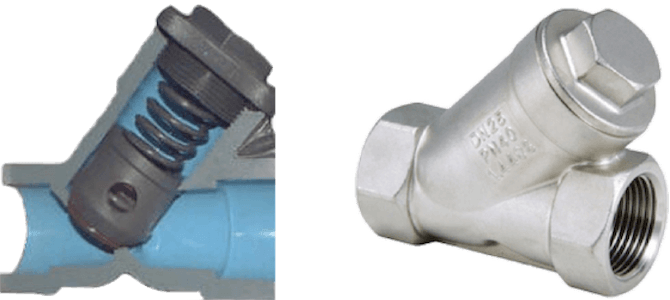Your Position: Home - Hardware - Swing Check Valves versus Spring Check Valves
Swing check valves are by far the most common check valve in many industry. They are usually the lower cost solution and are effective in most cases; however, it is important to understand the difference between a swing check valve and a spring check valve. Don't get confused!
In this article, we will cover some of the basic differences between these two types of straight-through check valves, as well as some of the advantages of using a spring-loaded check valve over a swing-open check valve.

The valve flap in a swing check valve 'swings' off the seat to allow forward flow and swings back onto the seat when flow stops. In contrast, a spring-loaded check valve contains a spring to assist in closing the check valve.
To learn more about spring check valve products, go to this website where you will find the hottest selling swing check valve products.
Swing check valves are limited in the direction of installation. Swing check valves can only be installed in horizontally oriented applications, which greatly limits the direction of installation. While swing check valves do provide greater flow (assuming the valve is fully open and has a greater CV), they are not always suitable for existing piping configurations. On the other hand, spring-loaded check valves can be installed in any flow direction if the proper spring is selected.
So if you have a skid mounted system, challenging spaces, or even unique piping orientations, choosing a spring check valve with the correct spring setting (aka spring break pressure) creates more possibilities for finding the right solution for your particular pumping system.
Spring check valves will help minimize the water hammer effect, which can be exacerbated by swing check valves. Any water hammer effect present in a piping system is likely to be amplified by a swing check valve.
Let's consider this basic example to explain the concept of water hammer: Suppose you have a pipeline with water and you have a check valve. Downstream of that check valve, you have a quarter-turn ball valve (this is one of the most common types of control valves used for smaller pipe sizes). Suppose water is flowing and someone suddenly closes the quarter-turn ball valve. This creates a pressure wave that flows through the pipe - this is called water hammer. Specifically for a swing check valve, the flap on that valve will be open until that pressure wave returns to the swing check valve. The pressure wave causes the valve flap to slam shut, which is easy to hear and causes excessive wear on swing check valves and other piping system components. Conversely, a spring-loaded check valve will help reduce and, in some cases, eliminate the effects of water hammer.
How? When we think of that same pressure wave that closes a swing check valve, the spring in the spring check valve closes before the pressure wave reaches it. Considered the "silent check valve," the spring check valve uses a spring to assist the spool in closing the check valve before the fluid flow reverses.
Suggested reading:680
0
0
Comments
All Comments (0)
Related Articles
Why Are Non-Sparking Tools Required?
Office safety and security have turned into one of the significant worries of the production industry. When it has to do with preventing work-related risks, particular needs must be satisfied, especially in ATEX-identified areas. One of the demands that must be taken care of is using precision hand tools.
By CC
138
0
0
A Guide to Choosing Explosion Proof Motors
While there are many different types of motors on the market, it is still especially important for any business to have an explosion proof motor, especially if there are any hazardous locations around the warehouse.
By CC
154
0
0
What is Flux-cored Wire for Hardfacing?
Flux-cored wire for hardfacing is a popular welding consumable used in various industries, including mining, construction, and manufacturing. This wire is designed to provide high-quality welding results by depositing a wear-resistant layer on the surface of the metal.
By CC
139
0
0
How to Choose Climbing Network?
Climbing is a very good sport, not only can exercise physical fitness, but also can enhance perseverance, adults and children like. Nowadays, there are climbing nets everywhere in the outdoor facilities, so what is the quality, specifications and price? Baron is here to help you.
By CC
152
0
0
8 Different Types of Water Valves Used in Home Plumbing
Water valves are an essential component of any plumbing system. They control the flow and pressure of water, making it possible to shut off the water supply to specific areas or fixtures when necessary. When it comes to plumbing systems, valves are essential components that control the flow of water in different parts of the system. There are various types of water valves used in home plumbing, each with its unique features and applications. Here are the eight most common types of water valves used in home plumbing:
By Ingrid
126
0
0
What Is the Difference Between Forged And Wrought Fittings?
When it comes to piping systems, fittings play a critical role in ensuring that the system functions properly.
By Ingrid
130
0
0
Things You Must Know about Steel Wire Rope!
Steel wire ropes are resilient and durable, constructed from intertwined steel wires. They serve vital roles in lifting, securing, and supporting heavy loads across multiple industries.
By Evelyn w
190
0
0
What’s a Throwout Bearing? We Tell You Here!
Technically speaking, the correct terminology for a throwout bearing is release bearing, as in clutch release bearing.
By Ingrid
102
0
0